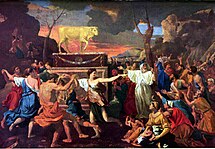

| Tammuz | |
|---|---|

Tammuz is the month of the sin of the golden calf, which resulted in Moses breaking the tablets of the Ten Commandments.
| |
| Native name | תַּמּוּז (Hebrew) |
| Calendar | Hebrew calendar |
| Month number | 4 |
| Number of days | 29 |
| Season | Summer (Northern Hemisphere) |
| Gregorian equivalent | June–July |
| Significant days | Seventeenth of Tammuz |
← Sivan
Av →
| |

Tammuz (Hebrew: תַּמּוּז, Tammūz), or Tamuz, is the tenth month of the civil year and the fourth month of the ecclesiastical year on the Hebrew calendar, and the modern Assyrian calendar. It is a month of 29 days, which occurs on the Gregorian calendar around June–July.
The name of the month was adopted from the Assyrian and Babylonian month Araḫ Dumuzu, named in honour of the Mesopotamian deity Dumuzid.
17 Tammuz – Seventeenth of Tammuz – is a fast day from 1 hour before sunrise to sundown in remembrance of Jerusalem's walls being breached. 17 Tammuz is the beginning of The Three Weeks, in which Jews follow similar customs as the ones followed during the Omer from the day following Passover until the culmination of the mourning for the death of the students of Rabbi Akiva (the 33rd day of the Omer – such as refraining from marriage and haircuts.)[1] The Three Weeks culminate with Tisha B'Av (9th of Av).
|
| |||||||||
|---|---|---|---|---|---|---|---|---|---|
| |||||||||
| |||||||||
Israeli ethnic |
| ||||||||
| Hebrew months |
| ||||||||
| |||||||||
| Authority control databases: National |
|
|---|